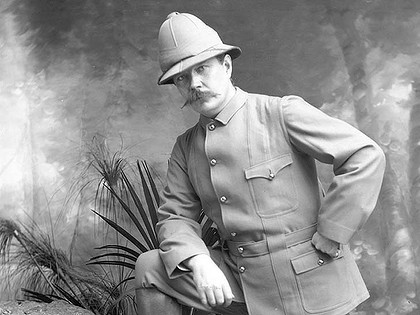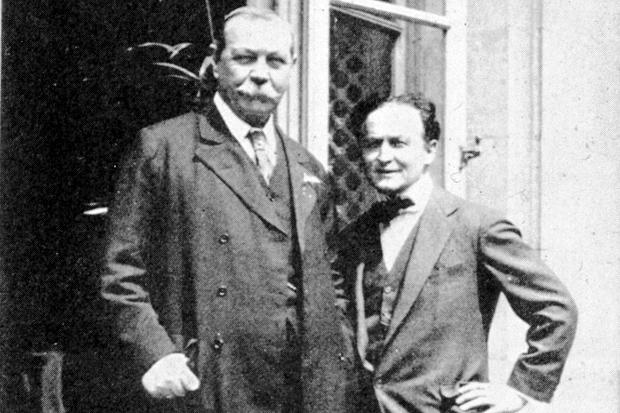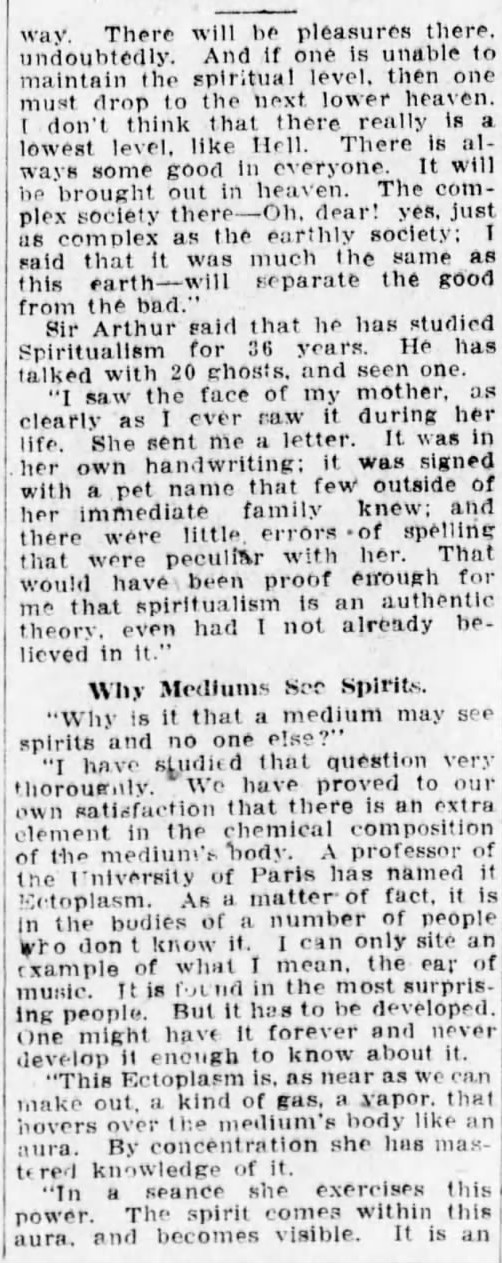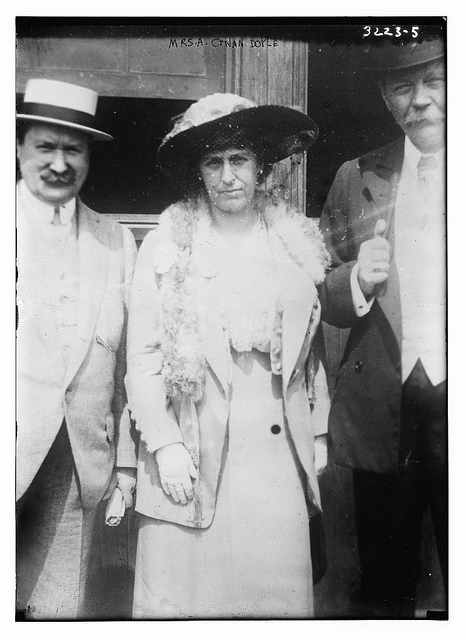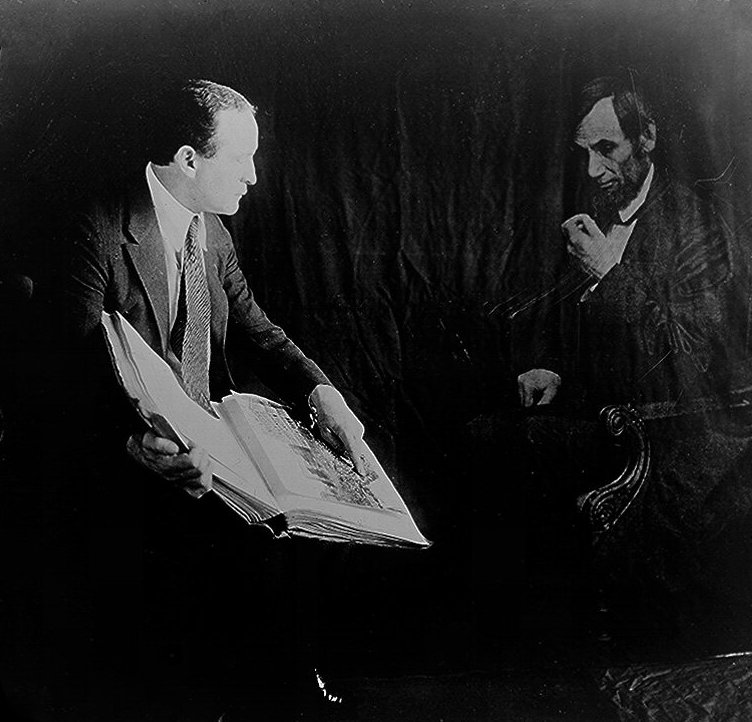Brilliant writer though he was, Sir Arthur Conan Doyle was gullible to lots of complete bullshit, mostly centered around spiritualist shenanigans, even believing frenemy Harry Houdini was doomed to an early death due to his skepticism. In an article in the April 10, 1922 Brooklyn Daily Eagle, the creator of Sherlock Holmes explained his vision of the afterlife, which he believed to be a childless place where a man could trade in his wife for a new model.
You are currently browsing articles tagged Arthur Conan Doyle.
Tags: Arthur Conan Doyle, Harry Houdini
We tell ourselves stories in order to live, Joan Didion wrote.
Like a lot of people searching for answers after the unexpected jolt of tragedy, Jean Elizabeth Leckie developed some odd beliefs that helped her get through it all. The second wife of Sir Arthur Conan Doyle, she, just like her spouse, was an ardent spiritualist. She came to believe after the heartbreaking death of her brother, a soldier killed in combat during WWI, someone she desperately needed to be waiting for her “on the other side.” In the April 29, 1923 Brooklyn Daily Eagle, an article delved into her personal relationship with the dead. An excerpt:
“I will say that from my analysis of her personality and her character and the super-evident vigor and keenness of her intellectuality, she is far from being one whose credulity can be readily imposed upon–that she is far from being one whose one self-willed thought can be swayed from its original course without the strongest proofs–material, moral and spiritual.
‘My husband has been a Spiritualist for thirty-six years,’ said she. ‘During long years I was in doubt. I have been a Spiritualist since the Battle of the Marne. My brother was killed there.
We became very frank in our talk after that. She told me she had nothing to conceal; that she hoped that Spiritualism might be spread throughout the world–that it meant the spread of the true religion. When she believed in the life hereafter life in this world took on such a different aspect that it was the duty of all who had investigated the other life to endeavor to link the two lives together.
‘We can help one another in this sphere and the higher sphere,’ she said. ‘They on the other side are ever anxious to communicate with us here. But we should aid them in that communication. From the earthly viewpoint, let me illustrate. There may be some one on your telephone wire who is anxious to talk to you, but if you have your receiver down you cannot hear from him. That is what we are apparently constantly doing in this world–and on the other side they are trying, trying, ever trying to reach us.
‘Oh, if we all only knew–if we all could only realize how like the world here is the world there–waiting to prepare the way for us–waiting to make a home for us. And if we are fond of certain things in this earth; if we like our home and the furniture and the pictures and the books in it; if we like our garden–all those will be there for us–duplicated–on the other side.’
‘But with a higher appeal?’ I queried.
 ‘Yes, with a higher appeal,’ she said. ‘All the material things that we like here may be duplicated there, but on the other side there is ever an advance. There are higher spheres than the sphere just beyond here. One goes to a sphere higher than the first sphere beyond this world as one becomes more fitted for the higher life. One who has gone to that higher sphere can come back to the first sphere to help relatives or friends who have just passed from the earth. But one cannot pass from the first sphere on the other side to higher spheres until one is advanced spiritually. For example: If a child dies its grandmother who had advanced to a higher sphere than the first, may come back to the first sphere to help the child.’
‘Yes, with a higher appeal,’ she said. ‘All the material things that we like here may be duplicated there, but on the other side there is ever an advance. There are higher spheres than the sphere just beyond here. One goes to a sphere higher than the first sphere beyond this world as one becomes more fitted for the higher life. One who has gone to that higher sphere can come back to the first sphere to help relatives or friends who have just passed from the earth. But one cannot pass from the first sphere on the other side to higher spheres until one is advanced spiritually. For example: If a child dies its grandmother who had advanced to a higher sphere than the first, may come back to the first sphere to help the child.’
‘In regard to childhood and old age,’ I said, ‘Sir Arthur told me that while there was no such thing as time, as we understood it, the apparent average age of the other side was about 35 years, that youth and old age adapted themselves to this apparent age.’
‘Yes,’ said she.
‘We often read,’ I said, ‘of a child or an old man appearing to persons sitting in a spiritualistic seance. How would you reconcile that with the 35-year age average?’
‘The spirits appear to their friends and relatives at the period of their lives when they passed away, so that they will be recognized,’ said she. …
Having been told by Sir Arthur Conan Doyle that Lady Doyle was an automatic writer, receiving messages from the Spirit World. I asked her as to her method.
‘I do not enter a trance,’ she said. ‘Two or three of us sit at a table. I have paper before me and a pencil in my hand. At the top of the paper I make the mark of the cross. Sir Arthur makes a sharp prayer–and he offers a very beautiful prayer–and then we wait. Generally I soon feel the desire to write. I am unconscious of what I am writing, but I know it is a direct communication from the other side. I know that.'”
_________________________________
Sir Arthur Conan Doyle discusses Sherlock Holmes and psychic experiences:
I came across this classic photograph of Harry Houdini and President Lincoln, and assumed it was the former debunking seances, which he loved to do. But it was actually a different kind of demystification–that of spirit photography. That phenomenon, which was first documented in the 1850s, supposedly showed ghosts of the dead making their presence known in photographs. It was a funereal kind of photobombing. In the 1920s, when Houdini created this image to show how phony the whole thing was, even bright people like Sir Arthur Conan Doyle were still arguing that spirit photography was genuine. From Kristi Finefield at the Library of Congress:
“In fact, Sir David Brewster, in his 1856 book on the stereoscope, gave step-by-step instructions for creating a spirit photo, beginning with:
‘For the purpose of amusement, the photographer might carry us even into the regions of the supernatural. His art, as I have elsewhere shewn, enables him to give a spiritual appearance to one or more of his figures, and to exhibit them as ‘thin air’ amid the solid realities of the stereoscopic picture.’
He went on to explain how this was easily done. Simply pose your main subjects. Then, when the exposure time is nearly up, have the ‘spirit’ figure enter the scene, holding still for only seconds before moving out of the picture. The ‘spirit’ then appeared as a semi-transparent figure, as seen in The Haunted Lane.
One of the more famous–and infamous–spirit photographers was William H. Mumler of Boston. He turned his ability to make photographs with visible spirits into a lucrative business venture, starting in the 1860s. Doubts grew about his work, but even when a spiritualist named Doctor Gardner recognized some of the so-called spirits as living Bostonians, people continued to pay as much as $10 a sitting. Mumler was charged with fraud in 1869, though not convicted, due to lack of evidence. However, his career as a photographer of the spirit world was essentially over.
Celebrities took sides in the debate in the 1920s. Famed author Sir Arthur Conan Doyle was an outspoken Spiritualist who believed that the supernatural could appear in photographs, while illusionist Harry Houdini denounced mediums as fakes and spirit photography as a hoax. Doyle and Houdini publicly feuded in the newspapers.
To demonstrate how easy it was to fake a photograph, Houdini had this image made in the 1920s, showing himself talking with Abraham Lincoln. He even based entire shows around debunking the claims of mediums and the entire idea of Spiritualism.”
Tags: Abraham Lincoln, Arthur Conan Doyle, David Brewster, Harry Houdini, Kristi Finefield, William H. Mumler


